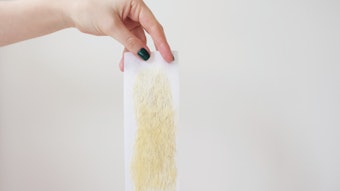
If the promise of a slimmer waistline hasn't curbed your sweet tooth, maybe the desire for smooth skin will. It's a bitter pill to swallow, but experts now believe that a lifetime of overeating sugar can make skin dull and wrinkled.
At blame is a natural process that's known as glycation, in which the sugar in your bloodstream attaches to proteins to form harmful new molecules called advanced glycation end products (or, appropriately, AGEs for short). The more sugar you eat, the more AGEs you develop. "As AGEs accumulate, they damage adjacent proteins in a domino-like fashion," explains Fredric Brandt, MD, a dermatologist in private practice in Miami and New York City and author of 10 Minutes 10 Years (Free Press, 2007). Most vulnerable to damage: collagen and elastin, the protein fibers that keep skin firm and elastic. In fact, collagen is the most prevalent protein in the body. Once damaged, springy and resilient collagen and elastin become dry and brittle, leading to wrinkles and sagging. These aging effects start at about age 35 and increase rapidly after that, according to a study published in the British Journal of Dermatology.
Besides damaging collagen, a high-sugar diet also affects what type of collagen you have—another factor in how resistant skin is to wrinkling, says Brandt. The most abundant collagens in the skin are types I, II and III, with type III being the most stable and longest lasting. Glycation transforms type III collagen into type I, which is more fragile. "When that happens, the skin looks and feels less supple," says Brandt. The final blow: AGEs deactivate your body's natural antioxidant enzymes, leaving you more vulnerable to sun damage—still the main cause of skin aging.
One group that knows all too well sugar's ravaging effects: people with diabetes, who—because they can suffer from years of undetected high blood sugar—often show early signs of skin aging. "Depending on how well their disease is controlled, diabetics can have up to 50 times the number of AGEs in their skin as those who don't have diabetes," says Karyn Grossman, MD, a dermatologist in New York City and Santa Monica, CA, and chief of the division of dermatology at St. John's Hospital in Santa Monica.
The good news about sugar-damaged skin: It's never too late to turn back the clock. One way is to build new collagen with products that contain retinoids—look for retinol in OTC serums and lotions or prescription creams such as Renova, Avage, and Differin. To keep this new collagen supple, prevent AGEs from forming by taking steps to minimize the damage sugar causes to your skin. Here, five steps to eat right and keep your skin looking its youngest:
1. Cut back on the sweet stuff in your diet. It's not easy to eliminate sugar completely. Even whole grains, fruits, and vegetables turn to glucose—the type of sugar that fuels glycation—when digested. But limiting added sugar can help. Some guidelines:
Keep added sugar to no more than 10% of total calories. If you're a 45-year-old woman of average height (5-foot-4), that's 160 calories (or 10 teaspoons) from added sugar—about the number in one 12-ounce can of Coca-Cola or six Hershey's Kisses. By comparison, the average American consumes 31 teaspoons per day of added sugar, or the equivalent of 465 calories.
Watch for hidden sugar in food. Many prepared foods contain hefty amounts of sugar—but it's hidden under aliases—including barley malt, corn syrup, dextrose, fruit juice concentrate, maltose, maple syrup, molasses and turbinado—on ingredient panels. The key is determining how many teaspoons of sugar each serving contains. Doing this is easy: Check the nutrition label for sugars, which are listed in grams under total carbohydrates, and then divide that number by 4 (each teaspoon of sugar is equal to 4 g) to convert it to teaspoons. For example, if sugars are listed as 12 g, you're getting 3 teaspoons of sugar per serving.
Avoid high fructose corn syrup. This type of sweetener, which is made by changing the sugar in cornstarch to fructose (another form of sugar), is believed to produce more AGEs than other types. Because HFCS extends the shelf life of foods and is sweeter and cheaper than other sugars, it's a popular ingredient in soda, fruit-flavored drinks, and packaged foods such as breads, crackers, and other snacks. You can spot it in ingredient lists on nutrition labels.
2. Supplement your diet with at least 1 mg of vitamins B1 and B6 a day. These vitamins proved to be potent AGE inhibitors in a number of published studies, says David J. Goldberg, MD, a New York City–based dermatologist and a clinical professor of dermatology at Mount Sinai School of Medicine. B1 and B6 are plentiful in food, but taking a multivitamin—most of which deliver at least 1 mg of both Bs—ensures you're getting the daily value of 1.1 mg for B1 and 1.3 mg for B6 (1.5 mg after age 50).
3. Wear broad-spectrum SPF 30 sunscreen every day. Significantly more AGEs occur in sun-exposed skin than in protected skin, according to the British Journal of Dermatology study.
4. Employ an inside-outside approach to antioxidants. These free-radical fighters help keep sugar from attaching to proteins, so replenishing their supply—both by eating more antioxidant-rich fruits, nuts, and vegetables, such as cranberries, walnuts, and red bell peppers, and by applying topical antioxidants such as green tea and vitamins C and E—is a real skin saver. "It seems to be the best way to ensure that they reach the dermal layer of skin, where collagen and elastin are located," says Goldberg.
5. Use new ingredients that protect skin from sugar. A growing number of products contain compounds like aminoguanidine and alistin, which have been shown to block the formation of AGEs. "Aminoguanidine attaches to molecules that start the glycation process and prevents them from binding to collagen and elastin," explains Grossman. "Alistin acts as a decoy, so it gets damaged instead of the proteins in your skin." In a study on Prescriptives Anti-AGE Advanced Protection Lotion SPF 25, which contains both ingredients, skin treated with the product had 21% fewer AGEs after 8 weeks than untreated skin. Sweet!
By Karyn Repinski, Prevention magazine, October 2007










